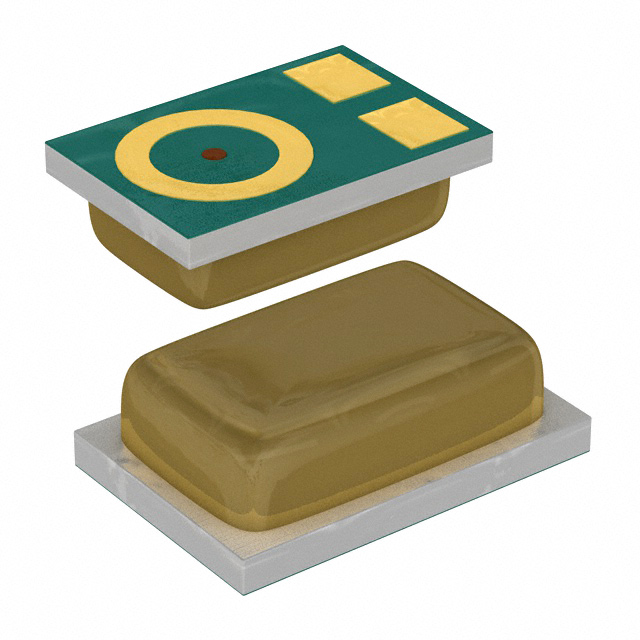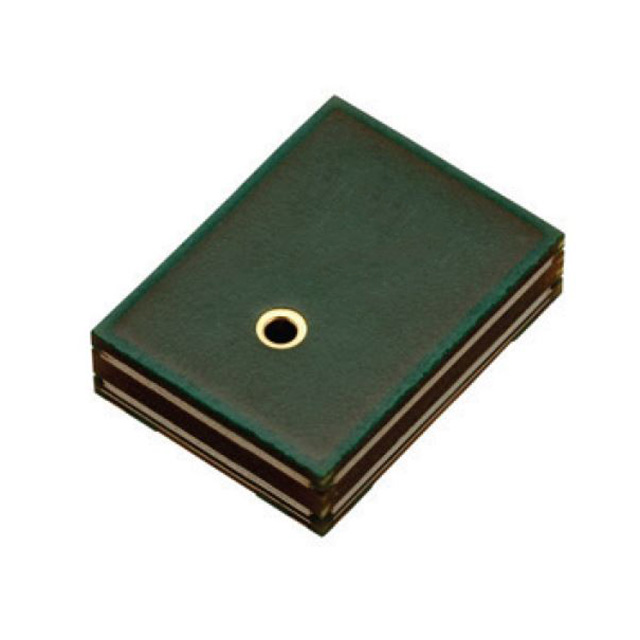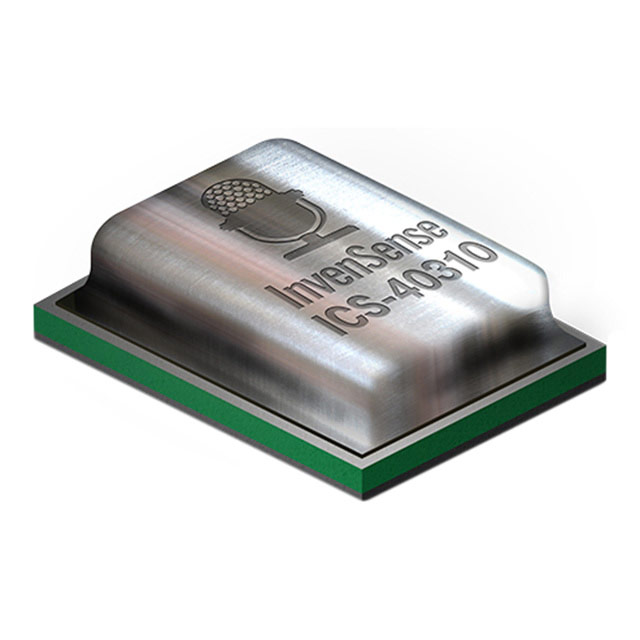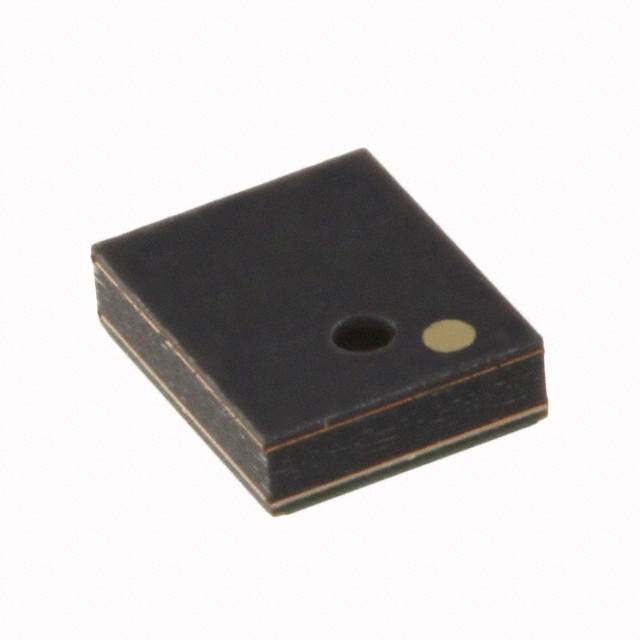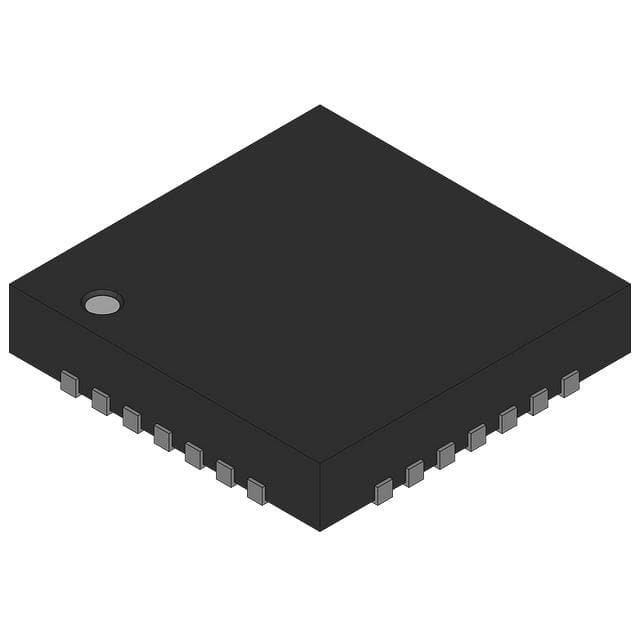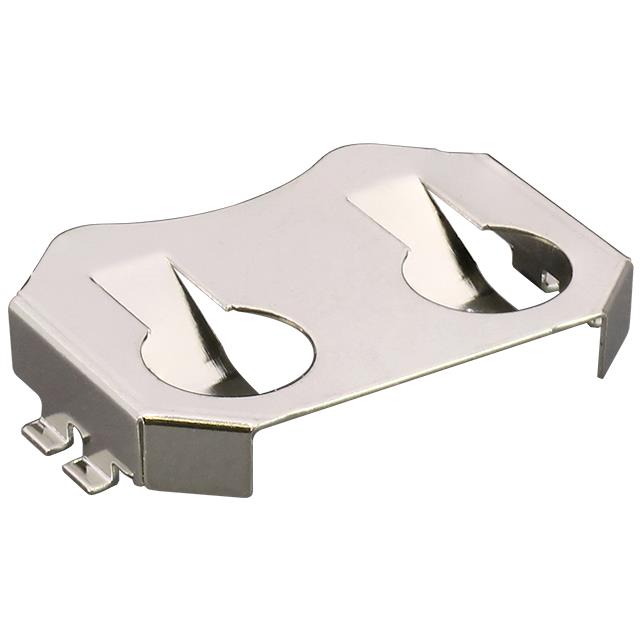STMicroelectronics STM32F103VET6
STM32F103VET6 development board introduction
STM32F103VET6 is a 32-bit microcontroller based on the ARM Cortex-M3 core produced by STMicroelectronics. It belongs to the high-performance product line of the STM32F1 series and is widely used in embedded applications such as industrial control, IoT devices, and home appliance control.
Main features of STM32F103VET6
Core: Based on the ARM Cortex-M3 core, the main frequency can reach up to 72 MHz, suitable for medium and high-performance embedded applications.
Storage:
Flash: It has 512 KB of Flash storage space, which is suitable for programs with a large amount of code.
SRAM: 64 KB of SRAM can be used to store runtime data.
Peripherals and interfaces:
ADC/DAC: There are 3× 12-bit ADCs, which are suitable for collecting sensor data, but there is no DAC output.
Timer: Equipped with up to 11 timers, including advanced timers, general timers and basic timers, suitable for PWM control, input capture, output comparison and other operations.
Communication interface: Provides a rich communication interface, including 5× UART, 3× SPI, 2× I2C, 1× CAN and USB 2.0 full-speed interface, suitable for various connection needs.
Operating voltage: Supports operating voltage from 2.0 V to 3.6 V, suitable for a variety of power supply environments.
Low power mode: Supports multiple low power modes, such as sleep mode, stop mode and standby mode, which helps to extend the working time of battery-powered devices.
Package type: STM32F103VET6 uses LQFP100 package and provides 100 pins for easy connection with external devices.
STM32F103VET6 application scenarios
STM32F103VET6 is suitable for a wide range of application scenarios due to its high performance, rich peripherals and low power consumption, including:
Industrial control system
Home appliance control and smart home
IoT node and gateway equipment
Audio equipment
Robot and drone control system
STM32F103VET6 Parameters
STM32F103VET6 vs STM32F105VBT6 vs STM32F107VBT6 vs STM32F105VCT6
| Parameter | STM32F103VET6 | STM32F105VBT6 | STM32F107VBT6 | STM32F105VCT6 |
|---|---|---|---|---|
| Image |  |  | 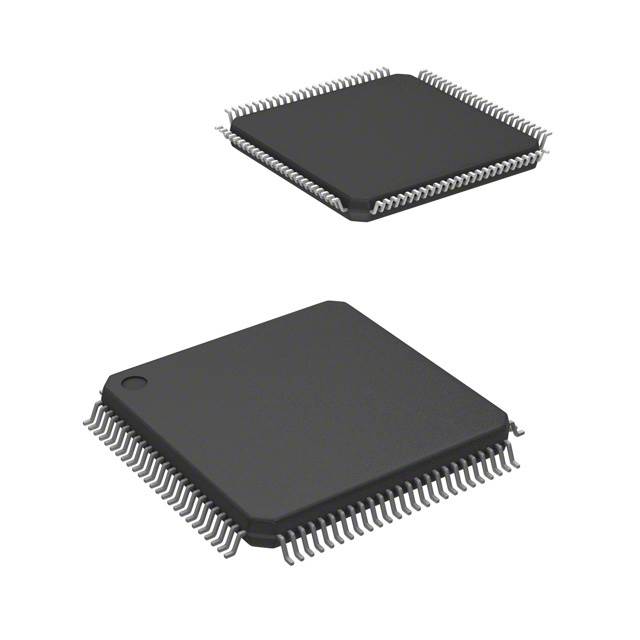 |  |
| Manufacturer | STMicroelectronics | STMicroelectronics | STMicroelectronics | STMicroelectronics |
| Core | ARM Cortex-M3 | ARM Cortex-M3 | ARM Cortex-M3 | ARM Cortex-M3 |
| Max Frequency | 72 MHz | 72 MHz | 72 MHz | 72 MHz |
| Flash Memory | 512 KB | 128 KB | 128 KB | 256 KB |
| SRAM | 64 KB | 64 KB | 64 KB | 64 KB |
| USB Support | USB 2.0 Full Speed (Device Only) | USB 2.0 Full Speed (Device/OTG) | USB 2.0 Full Speed (Device/OTG) | USB 2.0 Full Speed (Device/OTG) |
| Ethernet | No | No | Yes | No |
| CAN | 1× CAN | 1× CAN | 1× CAN | 1× CAN |
| ADC | 3× 12-bit ADC | 2× 12-bit ADC | 2× 12-bit ADC | 2× 12-bit ADC |
| DAC | No | 2× 12-bit DAC | 2× 12-bit DAC | 2× 12-bit DAC |
| Timers | 11 (advanced, general-purpose, basic) | 10 (general-purpose, basic) | 10 (general-purpose, basic) | 10 (general-purpose, basic) |
| Communication Interfaces | 5× UART, 3× SPI, 2× I2C, SDIO | 3× UART, 2× SPI, 2× I2C, SDIO | 3× UART, 2× SPI, 2× I2C, SDIO, Ethernet | 3× UART, 2× SPI, 2× I2C, SDIO |
| Operating Voltage | 2.0 V to 3.6 V | 2.0 V to 3.6 V | 2.0 V to 3.6 V | 2.0 V to 3.6 V |
| Package Type | LQFP100 | LQFP100 | LQFP100 | LQFP100 |
| Applications | Industrial control, IoT, general embedded | USB OTG applications, general embedded | Ethernet, USB OTG, networking | USB OTG applications, general embedded |
STM32F105VET6 PDF Datasheet
STM32F105VET6 Pinout
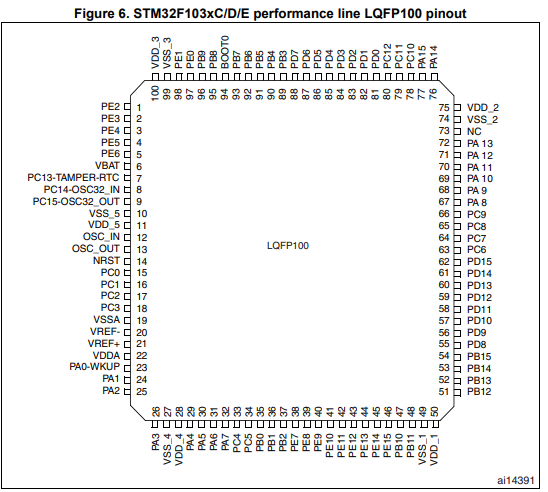
Development support
STM32F103VET6 is supported by STM32CubeMX and STM32CubeIDE, which provide rich initialization code and configuration interface to facilitate developers to get started quickly. In addition, third-party IDEs such as Keil MDK and IAR Embedded Workbench also support this chip and have complete documentation and sample code.
STM32F105VET6 similar or alternative
The STM32F105VET6 is a versatile microcontroller based on the ARM Cortex-M3 core, offering features like USB OTG, CAN, multiple communication interfaces (SPI, UART, I2C), and analog peripherals (ADC, DAC). If you're looking for similar or alternative microcontrollers in the STM32 family, here are some good options to consider:
1. STM32F107VET6
Core: ARM Cortex-M3 (same as STM32F105VET6)
Flash: 512 KB (same as STM32F105VET6)
SRAM: 64 KB (same as STM32F105VET6)
Key Differences:
Ideal For: Applications that require Ethernet networking in addition to USB OTG and CAN functionality.
2. STM32F205VET6
Core: ARM Cortex-M3 (same core)
Flash: 512 KB
SRAM: 128 KB (larger SRAM than STM32F105VET6)
Key Differences:
Ideal For: Applications requiring more RAM and advanced security features, along with USB OTG and CAN support.
3. STM32F407VET6
Core: ARM Cortex-M4 (upgraded core with FPU for floating-point operations)
Flash: 512 KB
SRAM: 192 KB (larger than STM32F105VET6)
Key Differences:
Ideal For: Applications that require higher computational performance, especially for signal processing or advanced mathematical operations.
4. STM32F103VET6
Core: ARM Cortex-M3 (same as STM32F105VET6)
Flash: 512 KB (same as STM32F105VET6)
SRAM: 64 KB (same as STM32F105VET6)
Key Differences:
Ideal For: General-purpose applications that do not require USB OTG or additional peripherals but still need a good balance of features.
5. STM32F302R8
Core: ARM Cortex-M4 (with FPU)
Flash: 128 KB
SRAM: 32 KB
Key Differences:
Ideal For: Applications requiring higher performance than STM32F105VET6 but with a smaller memory footprint, such as motor control or DSP (Digital Signal Processing) tasks.
6. STM32F051R8
Core: ARM Cortex-M0 (lower performance than STM32F105VET6)
Flash: 64 KB
SRAM: 8 KB
Key Differences:
Ideal For: Cost-sensitive applications with basic processing and fewer peripheral requirements.
Key Considerations for Substitution:
Performance Requirements: If you need higher computational performance (e.g., for signal processing), models like STM32F407VET6 or STM32F205VET6 would be better alternatives due to their more powerful cores.
Ethernet Connectivity: If your application needs Ethernet support, the STM32F107VET6 is a direct alternative, offering Ethernet along with USB OTG.
Security Features: If your project requires enhanced security features (e.g., encryption or hashing), then the STM32F205VET6 offers these features, unlike the STM32F105VET6.
These alternatives offer a range of performance, features, and peripheral support, allowing you to select a microcontroller based on your specific application needs, whether you require Ethernet, more memory, higher performance, or enhanced security.
STM32F105VCT6 FAQs
What is USB support on STM32F103VET6?
The STM32F103VET6 supports USB 2.0 Full-Speed (12 Mbps) as a device (not host). This means the microcontroller can function as a USB device connected to a USB host (e.g., PC), but it cannot function as a USB host that connects to other USB devices.
What development tools are compatible with STM32F103VET6?
STM32F103VET6 is supported by the STM32CubeIDE and STM32CubeMX tools for peripheral configuration, code generation, and software development.
Other popular development environments include:
STM32F103VET6 is also compatible with open-source environments like PlatformIO and Arduino (with specific libraries).
What are the power consumption options in STM32F103VET6?
Sleep mode: The CPU is stopped, but peripherals continue to function.
Stop mode: The CPU and most of the peripherals are stopped to reduce power consumption.
Standby mode: The microcontroller consumes the lowest amount of power, with most functions disabled except for the RTC (Real-Time Clock) and external interrupts.
What is the maximum clock speed of STM32F103VET6?
The STM32F103VET6 operates at a maximum clock speed of 72 MHz, which is sufficient for many embedded applications requiring moderate performance.
Can STM32F103VET6 be used for real-time applications?
Yes, the STM32F103VET6 is well-suited for real-time applications. Its Cortex-M3 core offers deterministic performance, and the presence of multiple timers, interrupt handling, and low-power modes make it effective for time-critical systems, such as motor control, sensor readings, and communication tasks.
What are the peripherals available on STM32F103VET6?
STM32F103VET6 includes a variety of peripherals, such as:
GPIO: Multiple general-purpose input/output pins.
USART: 3× Universal Synchronous Asynchronous Receiver Transmitter.
SPI: 2× Serial Peripheral Interface.
I2C: 2× Inter-Integrated Circuit.
ADC: 3× 12-bit analog-to-digital converters.
CAN: 1× Controller Area Network for automotive or industrial applications.
PWM: Advanced timers for Pulse Width Modulation (PWM).
USB: Full-Speed USB device interface.

